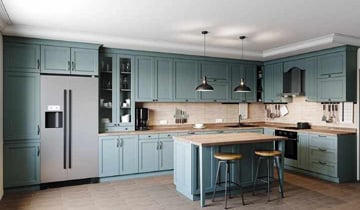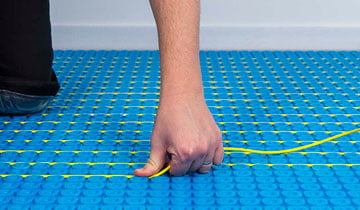6 min read
What’s the best underfloor heating to use in kitchens?
Kitchens are usually the most used living spaces in any home and are often not just for cooking but for entertaining in too. For the ‘heart of the...
5 min read
 Chris Hedges
:
Mar 17, 2022
Chris Hedges
:
Mar 17, 2022

In the latest Home Improvement Trends Report 2022 by Rated People, the perceived value that underfloor heating adds to a home is a whopping £12,290. The popularity of installing underfloor heating doesn’t show any signs of slowing down soon either. With a 33% increase in popularity in 2021, it is still seen as a huge benefit to a home. But not just in bathrooms, kitchens and conservatories, in living rooms and lounges too.
In our previous article ‘Electric underfloor heating and living rooms – the perfect match’ we touched upon why underfloor heating is perfectly suitable for living rooms. For this article, we’ll guide you through everything you need to know in detail before parting with any cash at your local retailer.
If you are short of time and want a quick answer to ‘what’s the best underfloor heating for living rooms or lounges?’ then get in touch via our contact page and one of our team will be on hand to help.
If you have more time, read on…
When looking at the benefits of installing underfloor heating, the same general benefits apply to both wet and electric underfloor heating. We’ve covered these in detail in previous articles but it’s always worth recapping.
Comfortable heat: Underfloor heating helps keep humidity in the air. The heat is distributed evenly throughout the room which creates more comfortable heat. The heat created using traditional central heating is much drier and much less comfortable.
Clean design: The trend in clean design and maximising space still sits high up on a homeowner’s priorities. This is a sweet spot for underfloor heating because installing it means you can free up wall space previously used by radiators and be granted better design freedom.
Zone control: Conserve energy by only heating the room you want heated rather than the whole house.
Better efficiency: Underfloor heating operates at a lower temperature than traditional central heating making it more efficient. For example, electric underfloor heating is 100% efficient at point of use. Each joule of energy paid for is used at the exact point where the heat it is needed.
Environmental credentials: Electric heating produces much less carbon emissions compared with gas alternatives such as traditional central heating which uses a gas boiler to heat the water in a network of pipes.
Health benefits: There certainly are! Read the ‘Can underfloor heating boost your health?’ blog post for the complete list…you’ll be surprised!
When it comes to living rooms or lounges, the most popular floor finishes are carpet, engineered wood or laminate and from this point onwards, we’ll be specifically focussing on electric underfloor heating rather than wet.
So, why does floor finish matter?
Unsurprisingly there are different types of electric underfloor heating systems available and some are better suited to certain floor finishes and floor build-ups than others. Because we are talking about living rooms and lounges, we’ll focus on the most popular floor finishes for these rooms…wood, carpet and vinyl.
Wooden floors
There are two types of wooden flooring to use with underfloor heating. Traditional solid timber flooring or engineered wood flooring.
Timber: A natural hardwood which has been treated and cut into boards to be used for flooring. Narrow kiln-dried floorboards are the best fit for underfloor heating because of their lower moisture content. The higher the moisture content the bigger the risk of the floor warping or bowing.
Engineered Wood: Man-made, engineered wood has a solid hardwood timber finish and a plywood backing. The laminated structure helps high quality engineered floors withstand natural expansion and contraction effectively without compromising the efficiency of the underfloor heating system. Cheaper options can swell over time due to a softer core which absorbs more moisture. The swelling can cause a failure of the floor covering so we always recommend that you consult the flooring manufacturer before fully installing an underfloor heating system.
If you decide upon engineered wood floor, it’s recommended that the ratio of thickness to width should be in the range of 7 to 11. For example, a board with a thickness of 16mm and width of 160mm would give a ratio of 10, so that’s ideal!
If need further detail about wooden floors and underfloor heating, read ‘The best underfloor heating for wooden floors’.
Carpet
Not many people know this, but you can use electric underfloor heating with a carpet floor finish. But there are some important points to be aware of.
Tog Rating: The maximum tog rating for a carpet to use with underfloor heating is 2.5 because anything more will cause it to not work as it should. Double check with the manufacturer if the carpet is suitable for underfloor heating before buying it.
Thermal Resistance: Any carpet underlay used should have a low thermal resistance and the carpet ideally should be hessian-backed rather than felt-backed because it’s much more ‘underfloor heating friendly’.
Floor Temperature: Under carpet we recommended a maximum temperature of 270C which can set using your underfloor heating thermostat.
Read ‘Can you use electric underfloor heating under carpet?’ for more detail should you decide you want a carpet floor finish in your living room or lounge.
Vinyl floors
Vinyl flooring such as Karndean is a popular choice of floor covering for open plan living rooms and provides an affordable alternative to other floor finishes. Many high-quality vinyl floors are hard wearing so ideal for high traffic areas such as living rooms. Similar to carpet, we recommend a maximum of 270C to help avoid any damage or discolouration.
Based on the most common floor finishes (wood, carpet or vinyl), a foil electric underfloor heating system like Warmup’s Foil Heater solution, Heat Mat’s 150W Combymat System and our own ThermoSphere Foil would be the perfect fit.
These types of electric underfloor heating systems provide great thermal conductivity and fast heat up times because the heating cable is wrapped by two layers of foil which is a ideal thermal conductor. At face value, these types of underfloor heating systems look similar but it is important to look for subtle differences which make some have a higher quality than others. For example, check that the cable loops accessible but are still sandwiched between two layers of aluminium. Also check if the heating wires are fully earthed by seeing if an earth braid wrapped around the heating wires.
Insulation board is worth it: Without insulation board, your underfloor heating system will take longer to heat the room because some of the heat is lost through the substrate and that costs you more money. By installing 10mm insulation board you can improve the efficiency of your system by up to 50%.
Beware of rugs and beanbags: Any flat-bottomed furniture or any rug with a tog rating of 2.5 and above should not be placed over a heated floor especially where the heating cable has been installed. Doing so will restrict the airflow to the floor and in turn cause ‘thermal blocking’ which could result in the heating cable overheating causing damage to the wood, carpet or vinyl floor finish.
Don’t risk overheating: Never underestimate the benefits of finding a thermostat to match your lifestyle. It will not only help you to be more energy efficient, it will ensure maximum temperature limits are not exceeded.
Run your electric underfloor heating between 210C and 250C for the time that you want it on. Remember not to exceed 270C because not only is it the European regulation for maximum floor surface temperature, it can also damage the floor finish as well as not very economical. When you want it to be effectively off, use a temperature of between 160C and 180C which can easily be done using a programmable thermostat.
As always, our superb team are on hand to help answer any further questions. Head on over to the contact us page to start the conversation or just give us a call on 0800 019 5899.

6 min read
Kitchens are usually the most used living spaces in any home and are often not just for cooking but for entertaining in too. For the ‘heart of the...

8 min read
If you are in the market for an electric underfloor heating system for your next home renovation, then you have landed in the perfect place. We’ve...

7 min read
If you are looking into buying and installing electric underfloor heating in your home, it’s vital that you understand and get the right heat output....